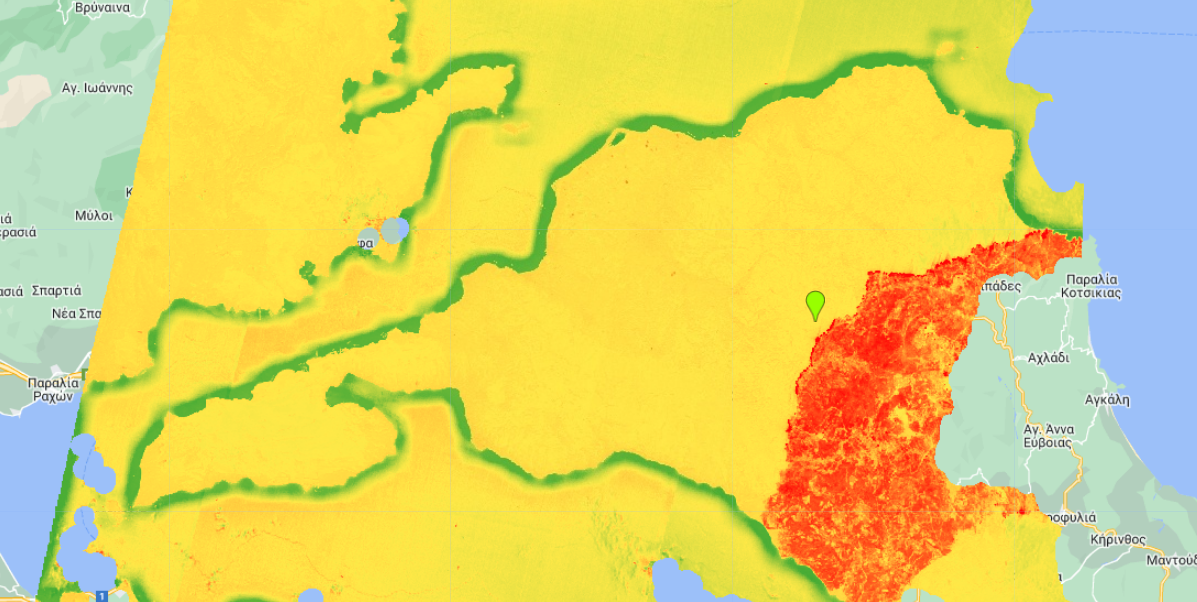11.2 Cloud-based geospatial data processing - An advanced example¶
NDVI computation¶
var landsat = ee.ImageCollection('LANDSAT/LC08/C02/T1')
.filterDate('2022-05-01', '2022-10-01')
.filterBounds(geometry)
print('Number of scenes:', landsat.size())
print("Image collection:", landsat)
// stretch 1 gamma
Map.addLayer(landsat.first(),
{bands: ["B4", "B3", "B2"]}, "RGB first scene")
var ndvi = landsat.first().normalizedDifference(["B5", "B4"])
print("NDVI first scene", ndvi)
Map.addLayer(ndvi, {min:0, max:1} , "NDVI first scene")
var composite = ee.Algorithms.Landsat.simpleComposite({
collection: landsat,
asFloat: true
})
print("Image composite", composite)
Map.addLayer(composite,
{bands: ["B4", "B3", "B2"], min:0, max: 0.3}, "RGB composite")
var ndvi_composite = composite.normalizedDifference(["B5", "B4"])
print("NDVI composite", ndvi)
Map.addLayer(ndvi_composite, {min:0, max:1} , "NDVI composite")
Tasks
- Play with vizualization parameters
- Change AOI
- Change dates
- Mask clouds
Wildfire analysis¶
Select AOI and time window based on wildfires reported for 2021 in Greece (Wikipedia).
Task
Import AOI NUTS region (https://geo.fsv.cvut.cz/courses/155isdp/data/11)
Mask clouds¶
// filter Selntinel-2 L2A based on spatial, temporal and metadata
var s2 = ee.ImageCollection('COPERNICUS/S2_SR')
.filterBounds(geometry)
.filterDate('2021-08-01', '2021-10-01')
.filter(ee.Filter.lt('CLOUDY_PIXEL_PERCENTAGE', 20));
print("Scenes:", s2);
// cloud mask based on QA layer
function mask_clouds(image) {
// Opaque and cirrus cloud masks cause bits 10 and 11 in QA60
// to be set, so values less than 1024 are cloud-free
var mask = ee.Image(0).where(image.select('QA60').gte(1024), 1).not();
return image.updateMask(mask);
}
// apply on image collection
var s2_masked = s2.map(mask_clouds);
// compare result
Map.addLayer(s2_masked.first(),
{min: 0, max: 3000, bands: ["B4", "B3" , "B2"]},
"RGB Image (masked)");
Map.addLayer(s2.first(),
{min: 0, max: 3000, bands: ["B4", "B3" , "B2"]},
"RGB Image");
Compute NBR¶
Normalized Burn Ratio (NBR) is an index designed to highlight burnt areas in large fire zones (link).
// compute normalized burn ratio
function add_NBR(image) {
return image.addBands(image.normalizedDifference(['B8', 'B12']).rename('NBR'));
};
var s2_nbr = s2_masked.map(add_NBR);
print(s2_nbr)
// NBR before fire appeared
var image0 = s2_nbr.first();
print(ee.Date(image0.get('system:time_start')));
Map.addLayer(image0,
{min: -1, max: 1, bands: ["NBR"]},
"NBR Image (before)");
// NBR after fire appeared
var image1 = ee.Image(s2_nbr.toList(1, 1).get(0));
print(ee.Date(image1.get('system:time_start')));
Map.addLayer(image1,
{min: -1, max: 1, bands: ["NBR"]},
"NBR Image (after)");
NBR time-series of the burned areas can be displayed by ui.Chart.image.series.
var TSChart = ui.Chart.image.series({
imageCollection: s2_nbr.select(['NBR']),
region: geometry,
reducer: ee.Reducer.mean(),
scale: 10,
}).setOptions({
title: 'NBR time-series of the burned areas'
});
print(TSChart);
Let's compute burn severity:
var dNBR = ee.Image().expression({
expression: 'image0.NBR - image1.NBR',
map: {image0: image0, image1: image1}
}).rename('dNBR');
Map.addLayer(dNBR,
{min: -1, max: 1, bands: ["dNBR"]},
"NBR Image (diff)");
Export image:
